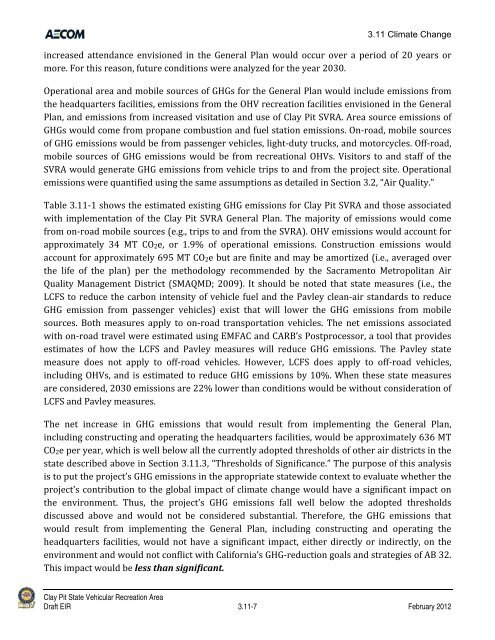Draft Environmental Impact Report - California Off Highway Vehicle ...
Draft Environmental Impact Report - California Off Highway Vehicle ...
Draft Environmental Impact Report - California Off Highway Vehicle ...
You also want an ePaper? Increase the reach of your titles
YUMPU automatically turns print PDFs into web optimized ePapers that Google loves.
3.11 Climate Change<br />
increased attendance envisioned in the General Plan would occur over a period of 20 years or<br />
more. For this reason, future conditions were analyzed for the year 2030.<br />
Operational area and mobile sources of GHGs for the General Plan would include emissions from<br />
the headquarters facilities, emissions from the OHV recreation facilities envisioned in the General<br />
Plan, and emissions from increased visitation and use of Clay Pit SVRA. Area source emissions of<br />
GHGs would come from propane combustion and fuel station emissions. On‐road, mobile sources<br />
of GHG emissions would be from passenger vehicles, light‐duty trucks, and motorcycles. <strong>Off</strong>‐road,<br />
mobile sources of GHG emissions would be from recreational OHVs. Visitors to and staff of the<br />
SVRA would generate GHG emissions from vehicle trips to and from the project site. Operational<br />
emissions were quantified using the same assumptions as detailed in Section 3.2, “Air Quality.”<br />
Table 3.11‐1 shows the estimated existing GHG emissions for Clay Pit SVRA and those associated<br />
with implementation of the Clay Pit SVRA General Plan. The majority of emissions would come<br />
from on‐road mobile sources (e.g., trips to and from the SVRA). OHV emissions would account for<br />
approximately 34 MT CO2e, or 1.9% of operational emissions. Construction emissions would<br />
account for approximately 695 MT CO2e but are finite and may be amortized (i.e., averaged over<br />
the life of the plan) per the methodology recommended by the Sacramento Metropolitan Air<br />
Quality Management District (SMAQMD; 2009). It should be noted that state measures (i.e., the<br />
LCFS to reduce the carbon intensity of vehicle fuel and the Pavley clean‐air standards to reduce<br />
GHG emission from passenger vehicles) exist that will lower the GHG emissions from mobile<br />
sources. Both measures apply to on‐road transportation vehicles. The net emissions associated<br />
with on‐road travel were estimated using EMFAC and CARB’s Postprocessor, a tool that provides<br />
estimates of how the LCFS and Pavley measures will reduce GHG emissions. The Pavley state<br />
measure does not apply to off‐road vehicles. However, LCFS does apply to off‐road vehicles,<br />
including OHVs, and is estimated to reduce GHG emissions by 10%. When these state measures<br />
are considered, 2030 emissions are 22% lower than conditions would be without consideration of<br />
LCFS and Pavley measures.<br />
The net increase in GHG emissions that would result from implementing the General Plan,<br />
including constructing and operating the headquarters facilities, would be approximately 636 MT<br />
CO2e per year, which is well below all the currently adopted thresholds of other air districts in the<br />
state described above in Section 3.11.3, “Thresholds of Significance.” The purpose of this analysis<br />
is to put the project’s GHG emissions in the appropriate statewide context to evaluate whether the<br />
project’s contribution to the global impact of climate change would have a significant impact on<br />
the environment. Thus, the project’s GHG emissions fall well below the adopted thresholds<br />
discussed above and would not be considered substantial. Therefore, the GHG emissions that<br />
would result from implementing the General Plan, including constructing and operating the<br />
headquarters facilities, would not have a significant impact, either directly or indirectly, on the<br />
environment and would not conflict with <strong>California</strong>’s GHG‐reduction goals and strategies of AB 32.<br />
This impact would be less than significant.<br />
Clay Pit State Vehicular Recreation Area<br />
<strong>Draft</strong> EIR 3.11-7 February 2012








